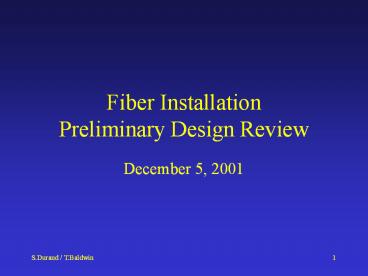Fiber Installation Preliminary Design Review - PowerPoint PPT Presentation
1 / 29
Title:
Fiber Installation Preliminary Design Review
Description:
Cable Installation. The IF system parameters were major factors in selecting fiber. ... Cable identified with marker tape. Splices identified with a concrete monument. ... – PowerPoint PPT presentation
Number of Views:102
Avg rating:3.0/5.0
Title: Fiber Installation Preliminary Design Review
1
Fiber InstallationPreliminary Design Review
- December 5, 2001
2
IF Signal Path
Buried Fiber
3
Cable Installation
- The IF system parameters were major factors in
selecting fiber. - The LO system parameters are major factors in
selecting an installation method.
4
Burial DepthDetermined by LO phase stability
- LO system requires phase stability.
- Stability determined partly by fiber thermal
expansion - Fiber in ground contributes to total expansion.
- Expansion determined by ground temperature
- LO short term stability must be lt 0.5 ps in 1sec.
- LO long term stability must be lt 1.4 ps in 30 min.
5
Burial DepthLO Parameters
- Highest transmitted LO is 500 MHz
- Period of 500 MHz is 2000 ps
- Wavelength of 500 MHz in fiber is 40 cm
6
Burial DepthFiber Thermal Expansion
- Coefficient of expansion of fiber 18 x 10-7
/C - ( From F. Quan, Corning, Inc. )
- Average annual temp. variation at 1 m 17.4 C.
- ( See EVLA Memo 10 by T. Cotter )
7
Burial DepthFiber Thermal Expansion
- Assuming
- A linear average rate of temperature change
- DL (18 x 10-7 /C)(17.4 C/yr)(22 km)
- 68 cm over 180 days
- 79 mm in 30 min
- 44 nm in 1 sec
8
Burial DepthLO Phase Instability
- Long Term LO phase stability in the ground
- Stability ( 79 mm in 30 min ) / ( 40 cm) /
(2000 ps) - 0.395 ps in 30 min ltlt 1.4 ps
- Short Term LO phase stability in the ground
- Stability ( 44 nm in 1 sec ) / ( 40 cm) /
(2000 ps) 0.00022 ps in 1 sec
ltlt 0.5 ps
9
Burial DepthSummary
- One meter burial depth is sufficient.
- Contribution of the buried fiber to the LO system
instability is small.
10
Cable Burial PlanFiber Acceptance Test
- Every fiber to be tested upon delivery.
- Every fiber to be tested after installation.
- Acceptance specification to be developed.
11
Cable Burial Plan
12
Basic Cabling Plan
C5
C6
12 Fibers per antenna
60 Fibers
C7
C8
Splice Box
C9
13
Cable Burial PlanTrunks
14
Cable Burial PlanDirect Burial Splice Box
15
Cable Burial PlanCable Type
- Armor protects the fiber from
- Rodents
- Crushing forces
- Armor - lightning protection issue
- Armor must be grounded
- First layer of armor is sacrificial
- Double armor is required
16
Cable Burial PlanCable Cross Section
17
Cable Burial PlanGrounding
- Bonded to ground at every connection.
- Bonded with 8 AWG copper, minimum.
- Bonded to antenna ground, control building
ground, or a ground rod.
18
Antenna TerminationAntenna Pad Enclosure
19
Antenna TerminationAntenna Junction Box
20
IF Signal Path
CB Main Distribution Frame
21
CB Main Distribution Frame
22
CB Main Distribution Frame Termination Panel
23
CB Main Distribution Frame Termination Panel
- Provisions for 876 fibers ( 73 Pads )
- Stores extra fiber for maintenance
- Space available for expansion to 1200 fibers
24
CB Main Distribution Frame Cable Type Required
- Plenum Cable Type OCNP is required in building
- 30-Fiber tight buffer cables will be used
- Twenty-one cables required
- Cables organized by array arm and system
25
CB Main Distribution Frame Patch Panels
26
Fiber InstallationWork Yet to be Accomplished
- Lightning protection
- What material will not react with the existing
cathodic protection system? Copper? - Further development of CB fiber plan
- Further development of Antenna cabling
- How will the cable wrap effect LO stability?
- Develop Installation Specification .
- CDR
27
Cable Burial PlanSummary
- 13 Trunk Cables from CB out to the Array.
- 60, 72 and 96 fiber cables.
- Triple Jacket/ Double Armor.
- Standard single-mode fiber.
- 17 splice locations
- 12-fiber cable from trunks to antennas.
- Acceptance Test before and after installation.
28
Cable Burial PlanSummary
- Trenched Installed by ES Division
- Spliced and terminated by Electronics Division
- Burial Depth - one meter minimum.
- Cable identified with marker tape.
- Splices identified with a concrete monument.
- Armor grounded at each splice or termination.
29
Next Topic

